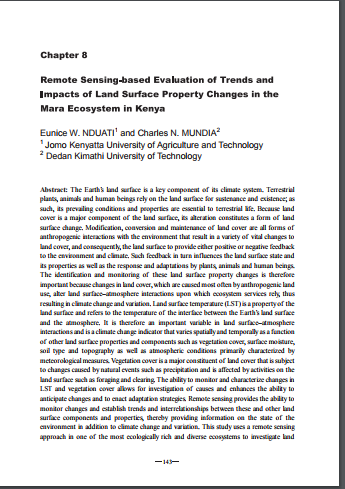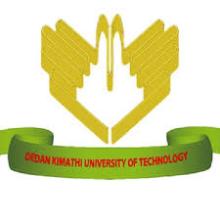Resource information
The Earth’s land surface is a key component of its climate system. Terrestrial plants, animals and human beings rely on the land surface for sustenance and existence; as such, its prevailing conditions and properties are essential to terrestrial life. Because land cover is a major component of the land surface, its alteration constitutes a form of land surface change. Modification, conversion and maintenance of land cover are all forms of anthropogenic interactions with the environment that result in a variety of vital changes to land cover, and consequently, the land surface to provide either positive or negative feedback to the environment and climate. Such feedback in turn influences the land surface state and its properties as well as the response and adaptations by plants, animals and human beings. The identification and monitoring of these land surface property changes is therefore important because changes in land cover, which are caused most often by anthropogenic land use, alter land surface–atmosphere interactions upon which ecosystem services rely, thus resulting in climate change and variation. Land surface temperature (LST) is a property of the land surface and refers to the temperature of the interface between the Earth’s land surface and the atmosphere. It is therefore an important variable in land surface–atmosphere interactions and is a climate change indicator that varies spatially and temporally as a function of other land surface properties and components such as vegetation cover, surface moisture, soil type and topography as well as atmospheric conditions primarily characterized by meteorological measures. Vegetation cover is a major constituent of land cover that is subject to changes caused by natural events such as precipitation and is affected by activities on the land surface such as foraging and clearing. The ability to monitor and characterize changes in LST and vegetation cover allows for investigation of causes and enhances the ability to anticipate changes and to enact adaptation strategies. Remote sensing provides the ability to monitor changes and establish trends and interrelationships between these and other land surface components and properties, thereby providing information on the state of the environment in addition to climate change and variation. This study uses a remote sensing approach in one of the most ecologically rich and diverse ecosystems to investigate land use/ land cover changes (LULCC), and in particular, vegetation and LST changes as indicators of land surface property changes. Furthermore, the study evaluates the relationship between LST and vegetation cover in the region using the normalized difference vegetation index (NDVI) as a parameter to characterize and assess vegetation. The study area includes the Mara ecosystem located in southwestern Kenya. Landsat satellite images for 1985, 1995, 2003 and 2010 were used to derive NDVI, LST and LULCC maps. We determined that human-related LULCC in the form of conversion of land for cultivation purposes is occurring near the Maasai Mara National Reserve. Moreover, we determined a negative correlation between LST and NDVI, thus indicating that a decrease in vegetation cover relates to an increase in LST in the region. Furthermore, a strong linkage was detected between land surface property changes and the population and distribution of wildlife in the region, particularly in large mammal species.



